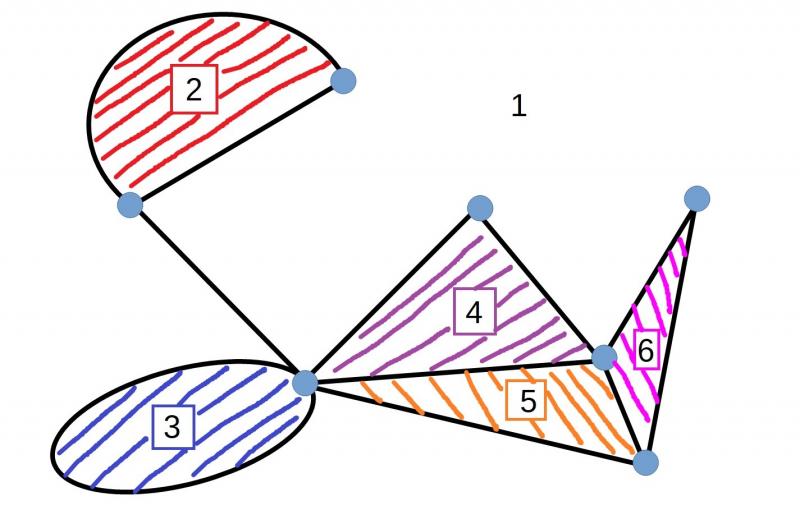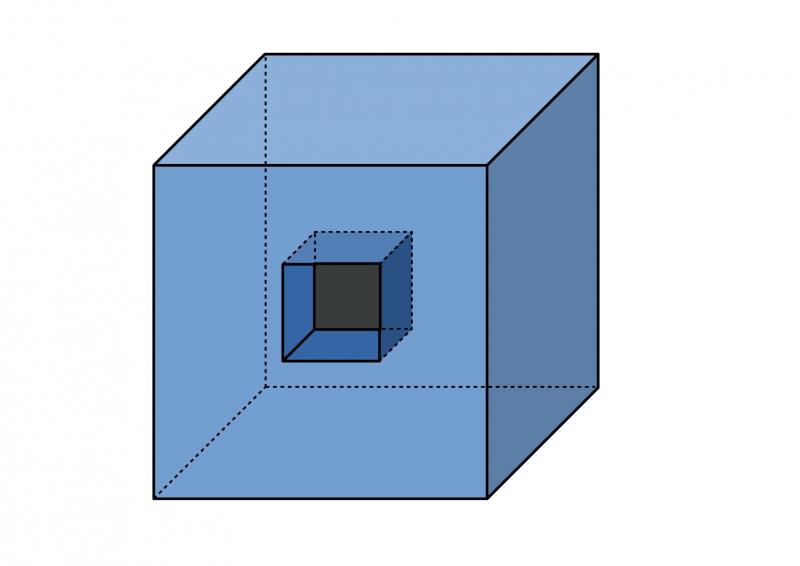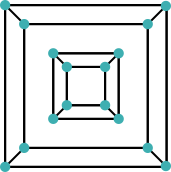Euler meets Schlegel
Discover how networks can be used to prove Euler's Polyhedron formula.
Problem
You might like to work on the problem Network Trees first.
A network consists of points (vertices) and lines between them (edges). A planar network is one where the edges do not cross each other, or which can be redrawn so that the edges do not cross. A connected network is one where you can travel to any vertex to any other vertex along the edges of the network.
A connected planar network (which has been redrawn if necessary so that edges do not cross) splits up the plane in which it lies into regions. The picture below shows a network which is dividing the plane into 6 regions (the space "outside" or "around" the network is counted as a region).

How many vertices, regions, and edges are there for this network?
Draw some different connected planar networks and count the number of
vertices (V), edges (E) and regions (R).
Can you find a rule connecting V, R and E ? (known as Euler's formula)
Can you explain why the rule works?
Schlegel Diagrams
This result for networks can also be applied to polyhedra. We can represent every polyhedron as a network using something called a Schlegel diagram. Consider a cube - we can imagine cutting a hole in a face, and then opening out this cut face and flattening the cube out (imagine the cube is made out of a flexible material so that we can stretch and manipulate it).
The resulting network has the same number of vertices and edges as the cube, and the number of regions in the network is the same as the number of faces of the cube.

For a triangular prism, we can consider cutting into a triangular face or into one of the rectangular faces, as shown below:

Draw Schlegel diagrams for each of these situations and some more polyhedra of your choice.
Check that the relationship you found between V, R and E still holds for these situations.
Extension
Draw a Schlegel diagram for a cube with an indent in one face (like the one below). It might be easiest to imagine cutting open the face opposite the indent.

Can you explain why you do not get the same relationship between V, E and R?
Student Solutions
Well done to Duncan from Wilson's School in England who sent in this solution.
Consider an existing connected planar network. Adding another [region] onto existing vertices would involve one less vertex added than edges created. The original shape is not disrupted. One more region is created.
An unconnected extension, consisting of a vertex at the end of an edge, will create no new regions.
Therefore, new regions that are connected to the old regions arise out of the difference between vertices and edges.
However, the first and second regions cannot build upon existing regions - they are new. The first region would be the surrounding area, and the second a shape made of equal numbers of vertices and edges. So, the first two regions can be established with no difference between vertices and edges.
The equation is $E-V+2=R$
In other words, by using the same number of vertices and edges, you can create two regions ('inside' and 'outside'), so $E - V + 2 = R$ when $E = V.$ After that, you can add 1 more region by adding 1 edge and 0 vertices, 2 edges and 1 vertex, 3 edges and 2 vertices and so on. Or you can add 1 edge and 1 vertex without changing the number of regions. Therefore the formula remains true as you add more vertices and edges to the network.
5 regions, 6 vertices, 9 edges 5 regions, 6 vertices, 9 edges
The relationship still holds true as these are connected planar shapes.
However, in a cube with an indent, the relationship does not hold as it is not connected. The indent is isolated and cannot be reached by an edge. It is like a separate network which shares the region of one face.

